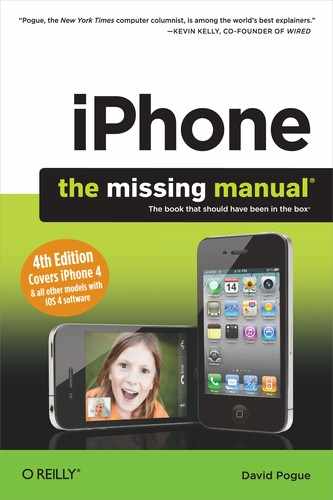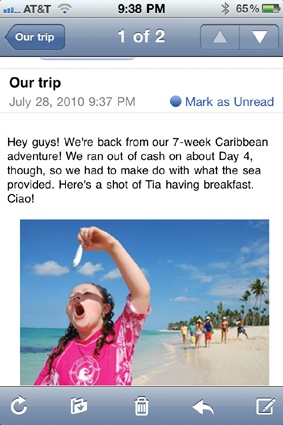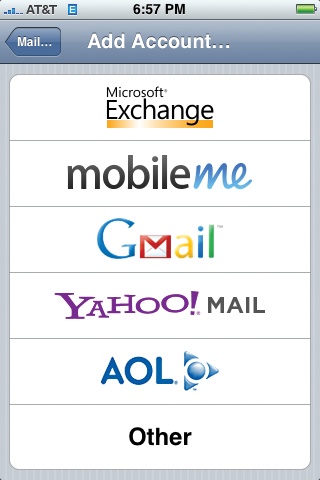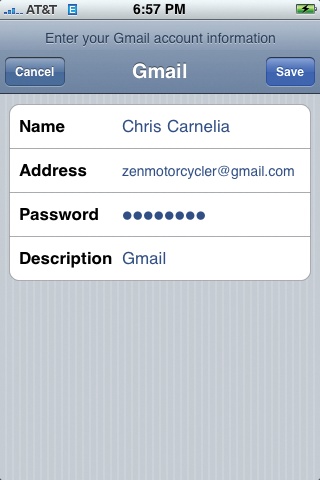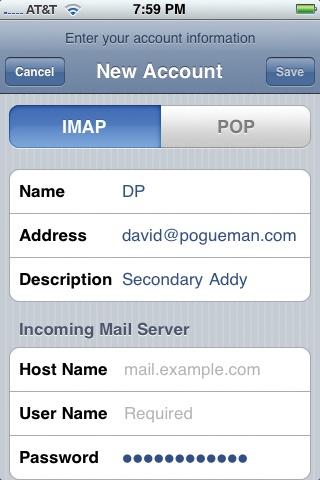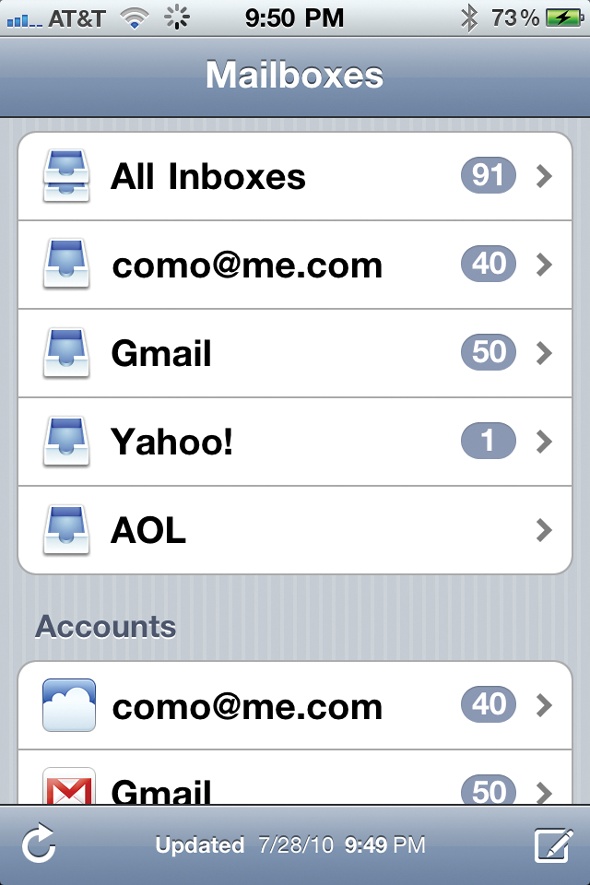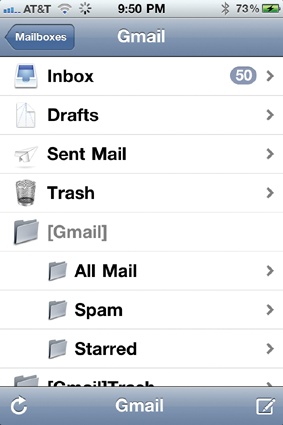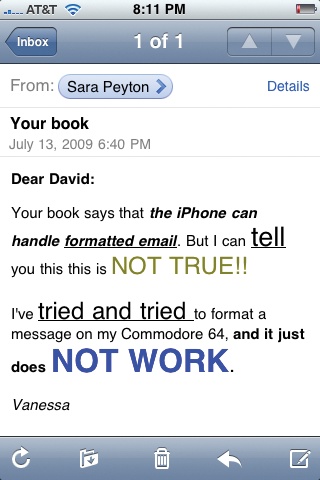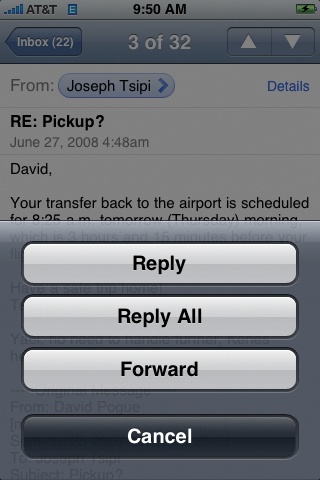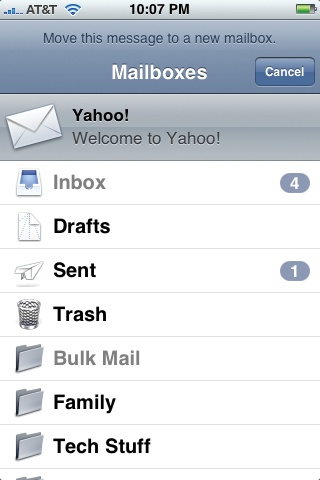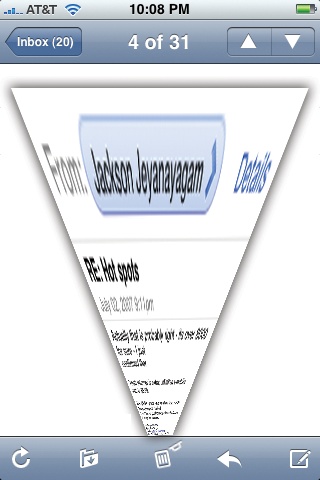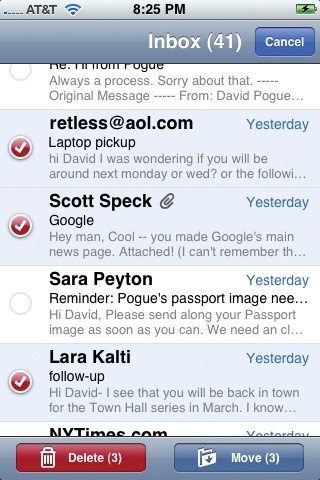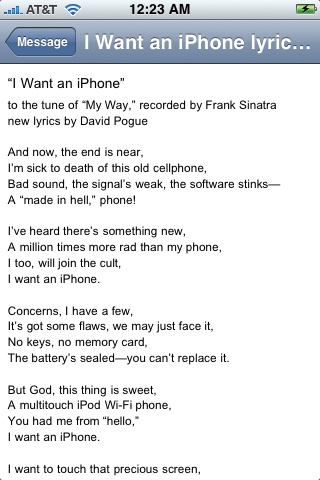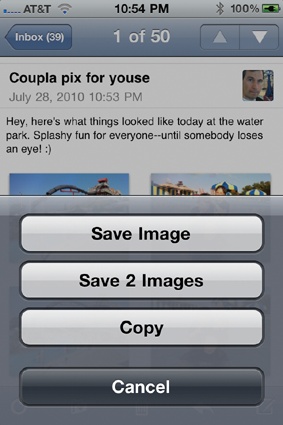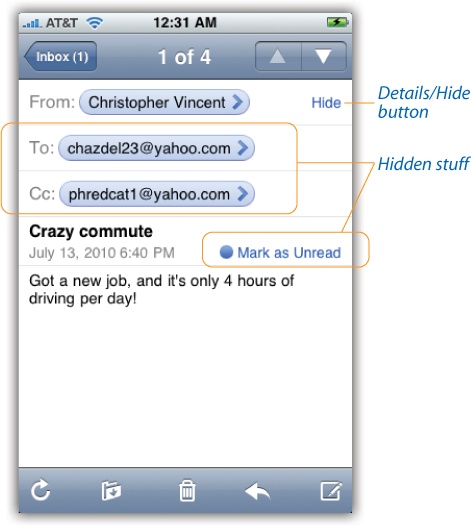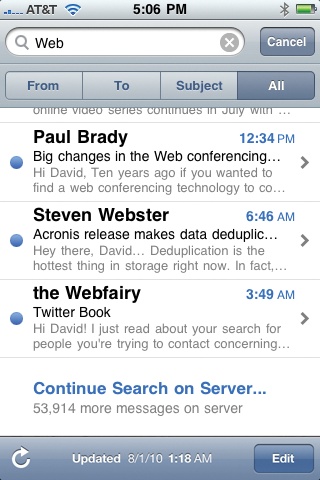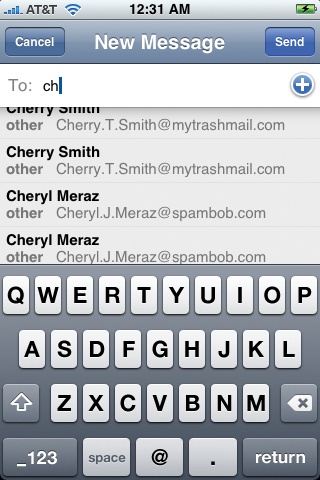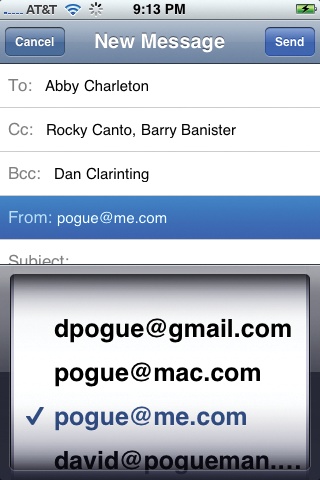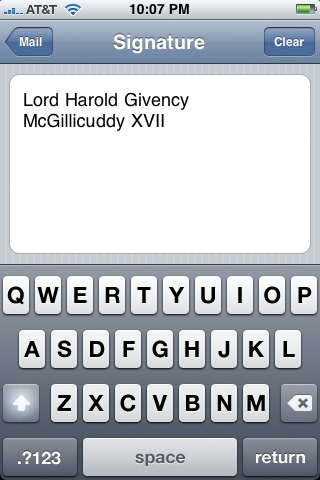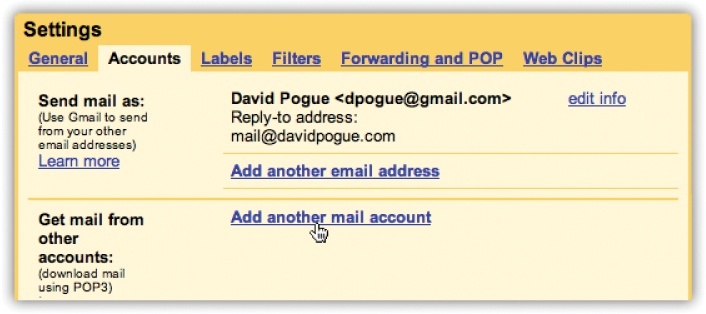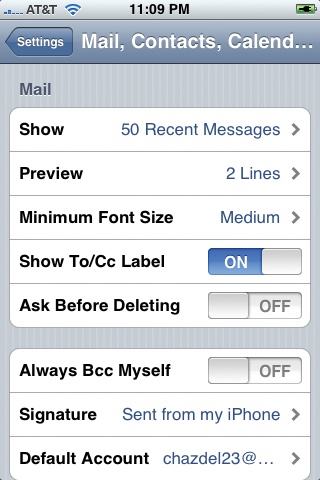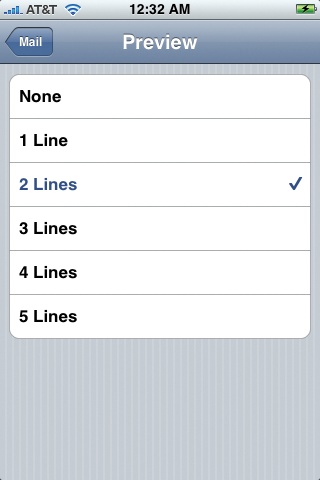Chapter 11. Email
You ain’t never seen email on a phone like this. It offers full formatting, fonts, graphics, and choice of type size; file attachments like Word, Excel, PowerPoint, PDF, Pages, Numbers, and photos; and compatibility with Yahoo Mail, Gmail, AOL Mail, MobileMe mail, corporate Microsoft Exchange mail, and just about any standard email account. Dude, if you want a more satisfying portable email machine than this one, buy a laptop.
This chapter covers the basic email experience, which has been thoroughly overhauled in iOS 4. If you’ve gotten yourself hooked up with MobileMe or Exchange ActiveSync, though, you’ll soon find out how wireless email syncing makes everything better. Or at least different. (See Chapters Chapter 13 and Chapter 14 for details.)
Setting Up Your Account
If you play your cards right, you won’t have to set up your email account on the phone. The first time you set up the iPhone to sync with your computer (Chapter 12), you’re offered the chance to sync your Mac’s or PC’s mail with the phone. That doesn’t mean it copies actual messages—only the email settings, so the iPhone is ready to start downloading mail.
You’re offered this option if your Mac’s mail program is Mail or Entourage or if your PC’s mail program is Outlook, Outlook Express, or Windows Mail.
But what if you don’t use one of those email programs? No sweat. You can also plug the necessary settings right into the iPhone.
Free Email Account
If you have a free email account from Google, AOL, or Yahoo; a MobileMe account (Chapter 13); or a Microsoft Exchange account run by your employer (Chapter 14), then setup on the iPhone is easy.
From the Home screen, tap Settings→Mail, Contacts, Calendars→Add Account. Tap the colorful logo that corresponds to the kind of account you have (Google, Yahoo, or whatever).
Now you land on the account-information screen. Tap into each of the four blanks and, when the keyboard appears, type your name, email address, account password, and a description (that one’s optional). Tap Save.
Your email account is ready to go!
Tip
If you don’t have one of these free accounts, they’re worth having, if only as a backup to your regular account. They can help with spam filtering, too, since the iPhone doesn’t offer any; see The Spam Problem. To sign up, go to Google.com, Yahoo.com, AOL.com, or Me.com.
POP3 and IMAP Accounts
Those freebie, Web-based accounts are super-easy to set up. But they’re not the whole ball of wax. Millions of people have a more generic email account, perhaps supplied by their employers or Internet providers. They’re generally one of two types:
POP accounts are the oldest, most compatible, and most common type on the Internet. (POP stands for Post Office Protocol, but this won’t be on the test.) But a POP account can make life miserable if you check your mail on more than one machine (say, a PC and an iPhone), as you’ll discover shortly.
A POP server transfers incoming mail to your computer (or iPhone) before you read it, which works fine as long as you’re using only that machine to access your email.
IMAP accounts Internet Message Access Protocol) are newer and have more features than POP servers, and they’re quickly catching up in popularity. IMAP servers keep all your mail online, rather than making you store it on your computer; as a result, you can access the same mail from any computer (or phone). IMAP servers remember which messages you’ve read and sent, and they even keep track of how you’ve filed messages into mail folders. (Those free Yahoo email accounts are IMAP accounts, and so are Apple’s MobileMe accounts and corporate Exchange accounts. Gmail accounts can be IMAP, too, which is awesome.)
There’s really only one downside to this approach: If you don’t conscientiously delete mail after you’ve read it, your online mailbox eventually overflows. On IMAP accounts that don’t come with a lot of storage, the system sooner or later starts bouncing new messages, annoying your friends.
Tip
The iPhone generally copies your IMAP messages onto the phone itself, so you can work on your email even when you’re not online. You can, in fact, control where these messages are stored (in which mail folder). To see this, open Settings→Mail, Contacts, Calendars→[your IMAP account name]→Account Info→Advanced. See? You can specify where your drafts, sent messages, and deleted messages wind up on the phone.
The iPhone can communicate with both kinds of accounts, with varying degrees of completeness.
If you haven’t opted to have your account-setup information transferred automatically to the iPhone from your Mac or PC, then you can set it up manually on the phone.
From the Home screen, tap Settings→Mail, Contacts, Calendars→Add Account. Tap Other, tap Add Mail Account, and then enter your name, email address, password, and an optional description. Tap Next.
Apple’s software attempts to figure out which kind of account you have (POP or IMAP) by the email address. If it can’t make that determination, then you arrive at a second screen, where you’re asked for such juicy details as the Host Name for Incoming and Outgoing Mail servers. (This is also where you tap either IMAP or POP, to tell the iPhone what sort of account it’s dealing with.)
If you don’t know this stuff offhand, you’ll have to ask your Internet provider, corporate tech-support person, or next-door teenager to help you.
When you’re finished, tap Save.
The “Two-Mailbox Problem”
It’s awesome that the iPhone can check the mail from a POP mail account, which is the sort provided by most Internet providers. This means, however, that now you’ve got two machines checking the same account—your main computer and your iPhone.
Now you’ve got the “two-mailbox problem.” What if your computer downloads some of the mail and your iPhone downloads the rest? Will your mail stash be split awkwardly between two machines? How will you remember where to find a particular message?
Fortunately, the problem is halfway solved by a factory setting deep within the iPhone that says, in effect: “The iPhone may download mail, but it will leave a copy behind for your desktop computer to download later.”
Tip
If you must know, this setting is at Settings→Mail, Contacts, Calendars→[your account name]→Account Info→Advanced.
Unfortunately, that doesn’t stop the opposite problem. It doesn’t prevent the computer from downloading messages before your iPhone can get to them. When you’re out and about, therefore, you may miss important messages.
Most people would rather not turn off the computer every time they leave the desk. Fortunately, there’s a more automatic solution: Turn on the Leave messages on server option in your Mac or PC email program. Its location depends on which email program you use. For example:
Entourage. Choose Tools→Accounts. Double-click the account name; click Options Turn on Leave a copy of each message on the server.
Mail. Choose Mail→Preferences→Accounts→[account name]→Advanced. Turn off Remove copy from server after retrieving a message
Outlook. Choose Tools→E-mail Accounts→E-mail. Click View or Change E-Mail Accounts→Next→[your account name]→Change→More Settings→Advanced. Turn on Leave a copy of messages on the server.
Outlook Express. ChooseTools→Accounts→[your account name]→Properties→Advanced. Turn on Leave a copy of messages on the server.
With this arrangement, both machines download the same mail; messages aren’t deleted until you delete them from the bigger computer.
Tip
Here’s another tip that may help: Turn on Always Bcc Myself (in Settings→Mail, Contacts, Calendars). It ensures that when you send a message from your iPhone, it fires off a copy to your own email address—so that when you return to your desk, you’ll have copies of all the messages you wrote from the road. (Yeah, they’ll be in your Inbox and not your Sent Mail, but at least it’s something.)
And consider getting (or forwarding your mail to) an IMAP account like MobileMe, Gmail, or Yahoo Mail, which avoids this whole mess. Then any changes you make on one machine are magically reflected on the other.
Downloading Mail
If you have “push” email (Yahoo, MobileMe, or Exchange), then your iPhone doesn’t check for messages; new messages show up on your iPhone as they arrive, around the clock.
If you have any other kind of account, then the iPhone checks for new messages
automatically on a schedule—every 15, 30, or 60 minutes. It also checks for new messages
each time you open the Mail program, or whenever you tap the Check button
(![]() ) within the Mail program.
) within the Mail program.
You can adjust the frequency of these automatic checks or turn off the “push” feature (because it uses up your battery faster) in Settings; see Mail, Contacts, Calendars.
When new mail arrives, you’ll know it by a glance at your Home screen, because the Mail icon sprouts a circled number that tells you how many new messages are waiting. You’ll also hear the iPhone’s little “You’ve got mail” sound, unless you’ve turned that off in Settings (Brightness). To read your new mail, tap Mail.
Note
If you have more than one email account, then this number shows you the total number of new messages, from all accounts. The Accounts screen, shown on the next page, shows the breakdown by account.
The Unified Inbox
If you have more than one email address, then iOS 4 was written for you. For the first time, the iPhone offers a unified Inbox—an option that displays all the incoming messages from all your accounts in a single place. (If you don’t see it—if Mail opened up to some other screen—keep tapping the upper-left button until you do.)
This Mailboxes page has two sections:
Inboxes To see all the incoming messages in one unified box, tap All Inboxes. You can, of course, also view the Inbox for any individual account in the top section shown here at left.
Accounts. Farther down the Mailboxes screen, you see your accounts listed again. Tap one to view the traditional mail folders: Inbox, Drafts (written but not sent), Sent, Trash, and any folders you’ve created yourself (Family, Little League, Old Stuff, whatever), as shown above at right. If you have a Yahoo, MobileMe, Exchange, or another IMAP account, then these folders are automatically created on the iPhone to match what you’ve set up online.
The Message List—and Threading
If you tap an Inbox’s name, you wind up face-to-face with the list of incoming messages. At first, you see only the subject lines of your messages, plus, in light-gray type, the first few lines of its contents; that way, you can scan through new messages and see if there’s anything important. You can flick your finger to scroll this list, if it’s long. Blue dots indicate messages you haven’t yet opened. Tap a message to read it in all its formatted glory.
Here and there, you may spot another new iOS 4 feature: threaded messages. That’s where several related messages—back-and-forths on
the same subject—appear only once, in a single, consolidated Inbox entry. (You’ll know
one when you see one, because the number of volleys in this exchange appears at the
right side of the message list, like this: ![]() ). The idea is to reduce Inbox clutter and help you remember what
people were talking about.
). The idea is to reduce Inbox clutter and help you remember what
people were talking about.
To read a normal message in the message list, you just tap it. But when you tap a threaded message, you first open an intermediate screen that lists the messages in the thread. Tap one of those to read, at last, the message itself.
Of course, this also means that to return to the Inbox, you have more backtracking to do (tap the upper-left button twice).
In general, threading is a nice feature, even if it accidentally clumps in a message that has nothing to do with the subject from time to time.
But if it bugs you, you can turn it off. Open Settings→Mail, Contacts, Calendars, scroll down, and turn off Organize By Thread.
What to Do with a Message
Once you’ve opened a message, you can respond to it, delete it, file it, and so on. Here’s the drill.
Read It
The type size in email messages can be pretty small. Fortunately, you have some great iPhoney enlargement tricks at your disposal. For example:
Drag or flick your finger to scroll through or around the message.
Tip
You can also, of course, just ask the iPhone to use a larger type size. From the Home screen, tap Settings→Mail, Contacts, Calendars→Minimum Font Size. You can choose the minimum type size you want from these options: Small, Medium, Large, Extra Large, or Giant. (What, no Humongous?)
It’s nice to note that links are “live” in email messages. Tap a phone number to call it, a Web address to open it, a YouTube link to watch it, an email address to write to it, a time and date to add it to your calendar, and so on.
Tip
If you’re using a Gmail account—a great idea—then any message you send, reply to, delete, or file into a folder is reflected on the Web at Gmail.com. Whether deleting a message really deletes it (after 30 days) or adds it to Gmail’s “archived” stash depends on the tweaky settings described at http://tinyurl.com/yokd27.
Reply to It
To answer a message, tap the Reply/Forward icon (![]() ) at the bottom of the screen. You’re asked if you want to Reply or
Forward; tap Reply. If the message was originally addressed to multiple recipients, then
you can send your reply to everyone simultaneously by hitting Reply All instead.
) at the bottom of the screen. You’re asked if you want to Reply or
Forward; tap Reply. If the message was originally addressed to multiple recipients, then
you can send your reply to everyone simultaneously by hitting Reply All instead.
A new message window opens, already addressed. As a courtesy to your correspondents, Mail places the original message at the bottom of the window.
Tip
If you select some text (Cut, Copy, Paste) before you tap, then the iPhone pastes only that selected bit into the new, outgoing message. In other words, you’re quoting back only a portion—just the way it works on a full-sized computer.
At this point, you can add or delete recipients, edit the Subject line or the original message, and so on. When you’re finished, tap Send.
Tip
Use the Return key to create blank lines in the original message. (Use the Loupe—Making the Keyboard Work—to position the insertion point at the proper spot.)
Using this method, you can splice your own comments into the paragraphs of the original message, replying point by point. The brackets by each line of the original message help your correspondent keep straight what’s yours and what’s hers.
Forward It
Instead of replying to the person who sent you a message, you may sometimes want to pass the note on to a third person.
To do so, tap the ![]() button at the bottom of the screen. This time, tap Forward.
button at the bottom of the screen. This time, tap Forward.
Tip
If there’s a file attached to the inbound message, the iPhone says, “Include attachments from original message?” and offers Include/Don’t Include buttons. Rather thoughtful, actually—the phone can forward files it can’t even open.
A new message opens, looking a lot like the one that appears when you reply. You may wish to precede the original message with a comment of your own, like, “Frank: I thought you’d be interested in this joke about your mom.”
Finally, address and send it as you would any outgoing piece of mail.
Filing or Deleting One Message
As noted earlier, some mail accounts let you create filing folders to help manage
your messages. Once you’ve opened a message that’s worth keeping, you file it by
tapping the ![]() button at the bottom of the screen. Up pops the list of your
folders (next page, left); tap the one you want.
button at the bottom of the screen. Up pops the list of your
folders (next page, left); tap the one you want.
It’s a snap to delete a message you no longer want, too. If it’s open on the screen
before you, simply tap the ![]() button at the bottom of the screen. Frankly, it’s worth deleting
tons of messages just for the pleasure of watching the animation as they funnel down
into that tiny icon, whose lid pops open and shut accordingly (facing page,
right).
button at the bottom of the screen. Frankly, it’s worth deleting
tons of messages just for the pleasure of watching the animation as they funnel down
into that tiny icon, whose lid pops open and shut accordingly (facing page,
right).
Tip
If that one-touch Delete method makes you a little nervous, you can ask the iPhone to display a confirmation box before trashing the message forever. See Mail.
You can also delete a message from the message list—the Inbox, for example. Just swipe your finger across the message listing, in either direction. (It doesn’t have to be an especially broad swipe.) The red Delete button appears; tap it to confirm, or tap anywhere else if you change your mind.
Tip
In a Gmail account, swiping like this produces a button that says Archive>, not Delete. That’s the Gmail way: It wants you to save everything. But you can change the button back so it says Delete. Tap Settings→Mail, Contacts, Calendars→[your Gmail account name]. Here, you can turn off Archive Messages. The button will now say Delete, and the messages you delete will really be deleted.
There’s a long way to delete messages from the list, too, as described below. But for single messages, the finger-swipe method is much more fun.
Filing or Deleting Batches of Messages
You can also file or delete a bunch of messages at once. In the message list, tap
Edit. A dot appears beside each message title. You can tap as many of these circles as
you like, scrolling as necessary, adding a ![]() with each touch.
with each touch.
Finally, when you’ve selected all the messages in question, tap either Delete or Move. (The number in parentheses shows how many you’ve selected).
If you tap Move, you’re shown the folder list so you can say where you want them moved. If you tap Delete, the messages disappear.
Note
When you delete a message, it goes into the Deleted folder. In other words, it works like the Macintosh Trash or the Windows Recycle Bin. You have a safety net.
Email doesn’t have to stay in the Deleted folder forever, however. You can ask the iPhone to empty that folder every day, week, or month. From the Home screen, tap Settings→Mail, Contacts, Calendars. Tap your account name, then Account Info→Advanced→Remove. Now you can change the setting from “Never” to “After one day” (or week, or month).
Add the Sender to Contacts
When you get a message from someone new who’s worth adding to your iPhone’s Contacts address book, tap the blue, oval-shaped email address (where it says “From:”). You’re offered two buttons: Create New Contact and Add to Existing Contact. Use the second button to add an email address to an existing person’s “card.”
Open an Attachment
The Mail program downloads and displays the icons for any kind of attachment—but it can open only documents from Microsoft Office (Word, Excel, PowerPoint), Apple iWork (Pages, Keynote, Numbers), PDF, text, RTF, .vcf, graphics, and un-copy-protected audio and video files.
Just scroll down, tap the attachment’s icon, wait a moment for downloading, and then marvel as the document opens up, full-screen. You can zoom in and zoom out, flick, rotate the phone 90 degrees, and scroll just as though it’s a Web page or photo.
Tip
If you hold your finger down on the attachment’s name, you get a list of ways to open it. “Quick Look” means the same non-editable preview as you’d get with a quick tap. But you might also see “Open in iBooks,” for example, or the name of another app that can open it. Tap the one you want.
When you’re finished admiring the attachment, tap Message (top-left corner) to return to the original email message.
Snagging a Graphic—Two Ways
One of the great joys of iPhone mail is its ability to display graphics that the sender embedded right in the message. And one of the great joys of iOS 4 is its flexibility in handling these graphics. Just hold your finger still on the picture. You’re offered two choices:
Save Image. Tap this button to copy the photo into your Photos program, along with the pictures you’ve taken yourself. To see it later, tap Photos on the Home screen, and then tap Camera Roll.
Copy. Here’s another place where Copy and Paste pay off. After tapping Copy, you can paste the photo into another email message, into an outgoing picture (MMS) message, or anywhere fine graphics are pasted.
View the Details
When your computer’s screen measures only 3 1/2 inches diagonally, there’s not a lot of extra space. So Apple designed Mail to conceal the details that you might need only occasionally. They reappear, naturally enough, when you tap Details in the upper-right corner of a message.
Now you get to see a few more details about the message. For instance:
Who it’s to. Well, duh—it’s to you, right? °Yes, but it might have been sent to other people, too. When you open the Details, you see who else got this note—along with anyone who was Cc’ed (sent a copy).
Mark as Unread. In the Inbox, any message you haven’t yet read is marked by a blue dot (
 ). Once you’ve opened the message, the blue dot goes
away.
). Once you’ve opened the message, the blue dot goes
away.By tapping Mark as Unread, however, you make that blue dot reappear. It’s a great way to flag a message for later, to call it to your own attention. The blue dot can mean not so much “unread” as “un–dealt with.”
Tap Hide to collapse these details.
Move On
Once you’ve had a good look at a message and processed it to your satisfaction, you
can move on to the next (or previous) message in the list by tapping the
![]() or
or ![]() button in the upper-right corner.
button in the upper-right corner.
Or you can tap the button in the upper-left corner to return to the Inbox (or whatever mailbox you’re in).
Searching
Praise be—there’s a Search box in Mail. It’s hiding above the top of every mail list, like your Inbox. To see it, scroll up, or just tap the status strip at the top of the screen.
Tap inside the Search box to make the keyboard appear. As you type, Mail hides all but the matching messages; tap one of the results to open it. (Note, however, that the iPhone doesn’t search the body of your messages—it can search only the From, To, or Subject lines, or all three at once. Bummer.)
At the very bottom, you may see a link called Continue Search on Server. It doesn’t appear for all email accounts, but it’s there when you’re in MobileMe, Gmail, and most other IMAP accounts. It’s intended to let you continue your To/From/Subject line search on email that’s not on your iPhone—that’s still out there on the Internet, usually because it’s so old that it’s scrolled off your phone. If the message you seek hasn’t appeared, Continue Search on Server is worth a try.
Writing Messages
To compose a new piece of outgoing mail, open the Mail program, and then tap the ![]() icon in the lower-right corner. A blank new outgoing message appears,
and the iPhone keyboard pops up.
icon in the lower-right corner. A blank new outgoing message appears,
and the iPhone keyboard pops up.
Tip
Remember: You can turn the phone 90 degrees to get a much bigger widescreen keyboard for email. It’s much easier to type this way.
Here’s how you go about writing a message:
In the “To:” field, type the recipient’s email address—or grab it from Contacts. Often, you won’t have to type much more than the first couple of letters of the name or email address. As you type, Mail automatically displays all matching names and addresses so you can tap one instead of typing. (It thoughtfully derives these suggestions by analyzing both your Contacts and which people you’ve recently exchanged email with.)
Tip
If you hold your finger down on the period (.) key, you get a pop-up palette of common email-address suffixes, like .com, .edu, .org, and so on.
Alternatively, tap the
 button to open your Contacts list. Tap the name of the person you
want. (Note, though, that the Contacts list shows you all names,
even those that don’t have email addresses.)
button to open your Contacts list. Tap the name of the person you
want. (Note, though, that the Contacts list shows you all names,
even those that don’t have email addresses.)You can add as many addressees as you like; just repeat the procedure.
Tip
There’s no Group feature on the iPhone, which would let you send one message to a predefined set of friends. But at http://groups.yahoo.com, you can create free email groups. You can send a single email message to the group’s address, and everyone in the group will get a copy. (You have to set up one of these groups in a Web browser—but lo and behold, your iPhone has one!)
Incidentally, if you’ve set up your iPhone to connect to a corporate Exchange server (Chapter 14), then you can look up anybody in the entire company directory at this point. Life on the Corporate Network has the instructions.
To send a copy to other recipients, enter the address(es) in the “Cc:” or “Bcc:” fields. If you tap Cc/Bcc, From, the screen expands to reveal two new lines beneath the “To:” line: Cc: and Bcc:.
Cc stands for carbon copy. Getting an email message where your name is in the Cc line implies: “I sent you a copy because I thought you’d want to know about this correspondence, but I’m not expecting you to reply.”
Bcc stands for blind carbon copy. It’s a copy that goes to a third party secretly—the primary addressee never knows you sent it. For example, if you send your coworker a message that says, “Chris, it bothers me that you’ve been cheating the customers,” you could Bcc your supervisor to clue her in without getting into trouble with Chris.
Each of these lines behaves exactly like the “To:” line. You fill each one up with email addresses in the same way.
Change the email account you’re using, if you like. If you have more than one email account set up on your iPhone, then you can tap Cc/Bcc, From to expand the form and then tap From: to open up a spinning list of your accounts (shown on the facing page). Tap the one you want to use for sending this message.
Type the topic of the message in the Subject field. It’s courteous to put some thought into the Subject line. (Use “Change in plans for next week,” for instance, instead of “Yo.”) And leaving it blank only annoys your recipient. On the other hand, don’t put the entire message into the Subject line, either.
Type your message in the message box. All the usual iPhone keyboard tricks apply (Chapter 2). Don’t forget that you can use Copy and Paste, too, within Mail or from other programs. Both text and graphics can appear in your message.
Note
You can’t attach anything to an outgoing message—at least not directly. You can email a photo or a video from within the Photos program (Three Ways to Send Photos or Videos), though; you can forward a file attached to an incoming piece of mail; and you can paste a copied photo or video (or several) into an open email message. Close enough.
Tap Send (to send the message) or Cancel (to back out of it). If you tap Cancel, the iPhone asks if you want to save the message. If you tap Save Draft, then the message lands in your Drafts folder.
Later, you can open the Drafts folder, tap the aborted message, finish it up, and send it.
Tip
If you hold down the ![]() button for a moment, the iPhone automatically opens your most
recently saved draft. Wicked cool!
button for a moment, the iPhone automatically opens your most
recently saved draft. Wicked cool!
Signatures
A signature is a bit of text that gets stamped at the bottom of your outgoing email messages. It can be your name, a postal address, or a pithy quote.
Unless you intervene, the iPhone stamps “Sent from my iPhone” at the bottom of every message. You may be just fine with that, or you may consider it the equivalent of gloating (or free advertising for Apple). In any case, you can change the signature if you want to.
From the Home screen, tap Settings→Mail, Contacts, Calendars→Signature. The Signature text window appears, complete with keyboard, so you can compose the signature you want.
Surviving Email Overload
If you don’t get much mail, you probably aren’t lying awake at night trying to think of ways to manage so much information overload on your tiny phone.
If you do get a lot of mail, here are some tips.
The Spam Problem
Mail is an awfully full-fledged email program for a phone. But compared with a desktop email program, it’s really only half-fledged. You can’t send file attachments, can’t create mail rules—and can’t screen out spam.
Spam, the junk mail that makes up more than 80 percent of email, is only getting worse. So how are you supposed to keep it off your iPhone?
The following solution will take 15 minutes to set up, but it will make you very happy in the long run.
Suppose your regular email address is [email protected].
Sign up for a free Gmail account. You do that at www.gmail.com.
The idea here is that you’re going to have all your [email protected] messages sent on to this Gmail account, and you’ll set up your iPhone to check the Gmail account instead of your regular account.
Why? Because Gmail has excellent spam filters. They’ll clean up the mail mess before it reaches your iPhone.
Unfortunately, just forwarding your mail to the Gmail account won’t do the trick. If you do that, then the return address on every message that reaches your iPhone will be [email protected]. When you tap Reply on the iPhone, your response won’t be addressed to the original sender; it’ll be addressed right back to you!
But the brainiacs at Google have anticipated this problem, too.
Sign in to Gmail. Click Settings→Accounts→“Add another mail account,” and fill in the email settings for your main address. Turn on “Leave a copy of retrieved message on the server.” What you’ve just done is told Gmail to fetch the mail from your main address. The return addresses of your incoming messages remain intact!
As you complete the setup process in Gmail, you’ll see a message that says: “You can now retrieve mail from this account. Would you also like to be able to send mail as [email protected]?”
If you click “Yes, I want to be able to send mail as [your real email address],” your iPhone should not only receive spam-filtered mail from your main account—but when you reply, your main email address also will be the return address, and not your Gmail address. In theory, at least.
This feature turns Gmail into a convenient, automatic, behind-the-scenes spam filter for your iPhone that leaves little trace of its involvement. (You can always change the outgoing account on a per-message basis; see Writing Messages.) In the meantime, at least all mail sent to your main address ([email protected]) will come to your iPhone prefiltered.
And as an added, added bonus, you can check your [email protected] email from any computer that has a Web browser—at Gmail.com.
Tip
Next time, keep your email address out of spammers’ hands in the first place. Use one address for the public areas of the Internet, like chat rooms, online shopping, Web site and software registration, and newsgroup posting. Spammers use automated software robots that scour these pages, recording email addresses they find. Create a separate email account for person-to-person email—and never post that address on a Web page.
How Many Messages
In Settings→Mail, Contacts, Calendars→Show (next page, left), you can specify how many messages you want to appear in the list before scrolling off the screen: 25, 50, 200, whatever.
It’s only a false sense of being on top of things—you can always tap the Load 25 More Messages button to retrieve the next batch—but at least you’ll never have a 2,000-message Inbox.
Condensing the Message List
As you may have noticed, the messages in your Inbox are listed with the Subject line in bold type and a couple of lines, in light-gray text, that preview the message itself.
You can control how many lines of the light-gray preview text show up here. From the Home screen, tap Settings→Mail, Contacts, Calendars→Preview. Choosing None means you fit a lot more message titles on each screen without scrolling; choosing 5 Lines shows you a lot of each message, but means you’ll have to do more scrolling.
Spotting Worthwhile Messages
The iPhone can display a little ![]() or
or ![]() logo on each message in your Inbox. At a glance, it helps you
identify which messages are actually intended for you. Messages
without those logos are probably spam, newsletters, mailing lists, or other messages
that weren’t specifically addressed to you.
logo on each message in your Inbox. At a glance, it helps you
identify which messages are actually intended for you. Messages
without those logos are probably spam, newsletters, mailing lists, or other messages
that weren’t specifically addressed to you.
To turn on these little badges, visit Settings→Mail, Contacts, Calendars and turn on Show To/CC Label. There’s no downside to using this feature.
Managing Accounts
If you have more than one email account, you might want to deactivate one for a while—for example, to accommodate your travel schedule. You can also delete an account.
Visit Settings→Mail, Contacts, Calendars. In the list of accounts, tap the one you want. At the top of the screen, you see the On/Off switch, which makes an account dormant. And at the bottom, you see the Delete Account button.
Tip
If you have several accounts, which one does the iPhone use when you send mail from other apps—like when you email a photo from Photos or a link from Safari?
It uses the default account, of course. You determine which one is the default account in Settings→Mail, Contacts, Calendars→Default Account.
